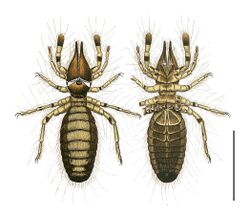Biology:Malleolus (arthropod)
From HandWiki
Malleolus (plural: malleoli) is a fan-shaped chemoreceptor or racquet organ, an array of which are carried in pairs on the ventral or undersides of Solpugidae. They are the counterpart of pectines in scorpions, and modified walking limbs in the uropygids and amblypygids as well as the pedipalps in spiders and other arachnids.[1][2] Most species have 5 pairs of malleoli on the ventral surface of the fourth pair of legs of both sexes, while juveniles and other species have 2-3 pairs.[3]
In most animals the central pathways of olfactory systems are associated with glomerular neuropil and lack topographic mapping of sensory inputs. Among arthropods, the insect and crustacean olfactory (antennal) pathways are typical examples. Two orders of chelicerate arthropods, the scorpions and solpugids (Cl. Arachnida), present striking exceptions to this generalization. The major chemosensory organs of scorpions are the pectines, two ventral appendages that contact the substrate intermittently as the animal searches for food or mates. In solpugids chemosensory input is from the antennalized pedipalps and first leg pairs, and from ten fan-shaped malleoli extending ventrally to the substrate from the 4th leg pair. The pectinal and malleolar sensory systems have highly ordered arrangement of 105 to 106 primary chemoreceptors, with one (pectines) forming a two-dimensional array and the other (malleoli) assembled in a linear array. The spatial frequencies of these chemoreceptive inputs exceed 100/mm and 1000/mm, respectively, indicating a capacity for resolving structure of chemical deposits on substrates. Using several histological and axonal tracing techniques, the organization of pectinal and malleolar central projections has been resolved. The pectinal projection terminates posteriorly in the cephalothoracic mass and shows a high degree of topographic precision, perhaps to the level of individual receptors in the sensory field. This chemosensory 'map' is imposed on laminar cytoarchitecture posteriorly in the brain but merges anteriorly into glomerular substructures. The sensory projection from the malleoli shows less topographic order with fewer and larger glomeruli reminiscent of the insect olfactory system. These comparisons between arthropod taxa suggest that olfactory projections are, to varying degrees, typically glomerular but may evolve topographic and laminar organization when the stimulus field is of fixed form.—Philip Brownell - Oregon State University
A malleolus comprises a basal stalk and a triangular fan, with epicuticular protrusions on each anterior face, and granular structures on each stalk, with undulate surfaces at each distal end.
Literature
- Babu, K. 1965. Anatomy of the central nervous system of arachnids. Zoologische Jahrbücher, Anatomie und Ontogenie 82: 1–154.
- Bernard, H. M. 1896. The comparative morphology of the Galeodidae. Transactions of the Linnean Society. 2d Series. Zoology 6: 305–417.
- Brownell, P. H. and R. D. Farley. 1974. The organization of the malleolar sensory system in the solpugid, Chanbria sp. Tissue & Cell 6: 471–485. CrossRef, PubMed
- Harvey, M. S. 2003. Catalogue of the Smaller Arachnid Orders of the World. CSIRO Publishing, Collingwood Victoria, Australia.
- Koç, H. 2007. The solifuges (Arachnida: Solpugida) fauna of southeast Anatolia: systematic zoogeography and ecology, PhD thesis, Ege University, İzmir, 241 pp. [in Turkish]
- Muma, M. H. (1951). "The Arachnid order Solpugida in the United States". Bulletin of the American Museum of Natural History 97: 35–141.
- Punzo, F. 1998. The Biology of Camel-spiders (Arachnida, Solifugae). Kluwer Academic Publishers, Boston, MA. 301 pp. CrossRef
- Ruhlemann, H. 1908. Uber die Facherorgane, sog. Malleoli oder Raquettes coxales, des vierten Beinpaares der Solpugiden. Zeitschrift fr wissenschaftliche Zoologie 91: 599–639.
- Nazife Yiğit, Melek Erdek, Halil Koç, and Abdullah Melekoğlu. 2011. Morphological Comparison of the Malleoli (Racquet Organs) in Biton zederbaueri and Gluviopsilla discolor (Daesiidae, Solifugae)
References
- ↑ Brownell, Philip H. (1998). "Glomerular Cytoarchitectures in Chemosensory Systems of Arachnidsa". Annals of the New York Academy of Sciences 855 (1): 502–7. doi:10.1111/j.1749-6632.1998.tb10614.x. PMID 10049228. Bibcode: 1998NYASA.855..502B.
- ↑ Brownell, Philip H.; Farley, Roger D. (1974). "The organization of the malleolar sensory system in the solpugid, Chanbria sp". Tissue and Cell 6 (3): 471–85. doi:10.1016/0040-8166(74)90039-1. PMID 4432235.
- ↑ http://www.biodiversityexplorer.org/arachnids/solifugids/[full citation needed]
 |




